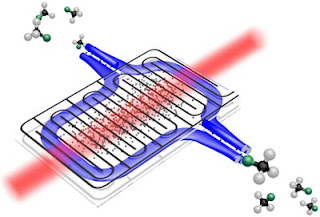 |
| Physics World |
In Greek mythology Sisyphus was condemned by the gods to repeatedly push a heavy boulder to the top of a hill, only to see it roll back down to the bottom. Now, physicists in Germany have used a similar scheme to cool a collection of fluoromethane molecules to a temperature of just a few thousandths of a kelvin. Cooling molecules with more than two atoms had proved very difficult and this latest development could lead to breakthroughs in chemistry, particle physics and even quantum computing.
Over the past few decades physicists have developed a variety of tools for cooling gases of atoms ever closer to absolute zero – with temperatures of less than a millionth of a kelvin reached. This has led to all sorts of breakthroughs, such as the creation of an unusual state of matter known as a Bose–Einstein condensate in which all of the constituent particles exist in a single quantum state.
Cooling molecules down to the same temperatures could also lead to major breakthroughs. Potential applications include the development of quantum computers, in which the necessary strong and stable interaction between quantum bits could be achieved via the long-range electrical forces between very low-energy polar molecules. Ultracold molecules might also be used in delicate processes that are impossible to carry out with warmer, more energetic particles, such as using electromagnetic fields to control chemical reactions at the molecular level or observing the tiny difference in energy between left- and right-handed chiral molecules predicted to follow from an inherent asymmetry in the electroweak force.
Physics World: Millikelvin cooling of large molecules is no myth
Comments